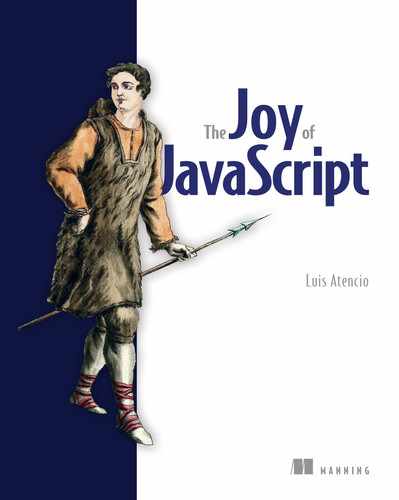0%
25Chapters
0-1Hours read
0kTotal Words
The Joy of JavaScript introduces techniques that turn JavaScript programmers into JavaScript pros. You’ll work with cutting edge APIs, language features, and coding styles to tackle tricky problems in an elegant manner. Along the way, you’ll practice good object design, drive business logic with functional thinking, and untangle complex data flows.
Table of Contents
- inside front cover
- The Joy of JavaScript
- Copyright
- dedication
- brief contents
- contents
- front matter
- 1 JavaScript reloaded
- Part 1. Objects
- 2 Inheritance-based object modeling
- 3 Linked, compositional object models
- 3.1 Types of object links
- 3.1.1 Implicit
- 3.1.2 Explicit
- 3.2 OLOO
- 3.3 Understanding Object.assign
- 3.3.1 Object.assign uncovered
- 3.3.2 Assignment vs definition
- 3.4 Assembling objects using mixin composition
- 3.4.1 Anatomy of a mixin
- 3.4.2 Multiple inheritance and linearization
- 3.4.3 Composing objects using Object.assign and the spread operator
- 3.5 Applying shared mixins to multiple objects
- Summary
- Part 2. Functions
- 4 Writing composable, pure code
- 4.1 What is functional programming?
- 4.1.1 Functions as data
- 4.1.2 The functional way
- 4.2 Functional versus imperative at a glance
- 4.3 Composition: The functional way
- 4.3.1 Working with side effects
- 4.3.2 Decomposing complex code
- 4.4 Currying and closures
- 4.4.1 Curried function application
- 4.4.2 The curry and composition dynamic duo
- 4.5 Working with immutable objects
- 4.6 Point-free coding
- 4.7 Imperative to functional transformation
- 4.8 Native function chains
- Summary
- 5 Higher-kinded composition
- 5.1 Closing over data types
- 5.2 New Array APIs: {flat, flatMap}
- 5.2.1 Array.prototype.flat
- 5.2.2 Array.prototype.flatMap
- 5.3 The map/compose correspondence
- 5.4 Universal contracts
- 5.4.1 Functors
- 5.4.2 Monads
- 5.5 Contextual validation with higher-order functions
- 5.5.1 Kinds of ADTs
- 5.5.2 Choices
- 5.5.3 Modeling success and failure with the Validation monad
- 5.5.4 Composing with monads
- 5.5.5 Higher-kinded composition with Validation
- 5.5.6 Point-free coding with monads
- 5.5.7 Reducing complex data structures
- 5.5.8 Third-party integration
- 5.6 Higher-kinded composition with method extraction and dynamic binding
- Summary
- Part 3. Code
- 6 ECMAScript Modules
- 6.1 Past state of affairs
- 6.2 Module patterns
- 6.2.1 Object namespaces
- 6.2.2 Immediately Invoked Function Expressions (IIFEs)
- 6.2.3 IIFE mixins
- 6.2.4 Factory functions
- 6.3 Static vs. dynamic module systems
- 6.4 ESM basics
- 6.4.1 Path specifiers
- 6.4.2 Exporting
- 6.4.3 Importing
- 6.4.4 A new extension in town
- 6.5 Benefits of ESM for tooling
- 6.5.1 Dead-code elimination and tree-shaking
- 6.5.2 Faster property lookups
- 6.5.3 Type-friendliness
- Summary
- 7 Hooked on metaprogramming
- 7.1 Common uses of metaprogramming in JavaScript
- 7.2 JavaScript symbols
- 7.3 Symbol registries
- 7.3.1 Local registry
- 7.3.2 Global registry
- 7.4 Practical application of symbols
- 7.4.1 Hidden properties
- 7.4.2 Interoperability
- 7.4.3 Serialization
- 7.5 Well-known symbols
- 7.5.1 @@toStringTag
- 7.5.2 @@isConcatSpreadable
- 7.5.3 @@species
- 7.5.4 @@toPrimitive
- 7.5.5 @@iterator
- 7.6 Dynamic introspection and weaving
- 7.6.1 Proxy objects
- 7.6.2 The Reflect API
- 7.6.3 Additional use cases
- 7.7 Implementing method decorators
- Summary
- Part 4. Data
- 8 Linear async flows
- 8.1 Architecture at a glance
- 8.2 JavaScript as promised
- 8.2.1 Principle of data locality
- 8.2.2 Are promises algebraic?
- 8.2.3 Fluent chaining
- 8.2.4 Promises in the wild
- 8.3 API review: Promise combinators
- 8.3.1 Promise.all
- 8.3.2 Promise.race
- 8.3.3 Promise.allSettled
- 8.3.4 Promise.any
- 8.4 async made easy
- 8.5 async iteration
- 8.6 Top-level await
- Summary
- 9 Streams programming
- 9.1 Iterables and Iterators
- 9.1.1 Iterable protocol
- 9.1.2 Iterator protocol
- 9.1.3 Examples
- 9.2 Generators
- 9.2.1 To return or to yield
- 9.2.2 Creating iterable objects
- 9.2.3 Async generators
- 9.3 Working with data streams
- 9.3.1 What is a stream?
- 9.3.2 Implementing a streamable array
- 9.4 Welcoming a new native: Observable
- 9.4.1 What is an Observable?
- 9.4.2 Creating custom observables
- 9.4.3 Building your own reactive toolkit
- 9.4.4 Observable mixin extension
- 9.4.5 Representing push streams with generators
- 9.4.6 Pipeable operators
- 9.4.7 Streamifying objects
- 9.4.8 Dynamic streamification
- 9.5 Closing thoughts
- Summary
- appendix A. Configuring Babel
- appendix B. Typed JavaScript<T>
- index
- PATTERNS OF COMPOSABLE SOFTWARE
